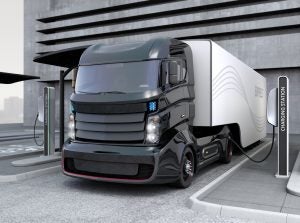Groundbreaking clean truck initiative will reduce air pollution in California
 California recently released new details of a plan to bring more affordable electric trucks, vans and buses to market while also reducing harmful air pollution. The latest proposal reflects calls from California Air Resources Board members to increase the number of electric trucks sold under the rule and to ensure that the benefits of cleaner air they bring will reach disadvantaged communities.
California recently released new details of a plan to bring more affordable electric trucks, vans and buses to market while also reducing harmful air pollution. The latest proposal reflects calls from California Air Resources Board members to increase the number of electric trucks sold under the rule and to ensure that the benefits of cleaner air they bring will reach disadvantaged communities.
If adopted, the state will require truck manufacturers to produce more electric or zero-emission vehicle options. Beginning in 2024, at least 9% of vocational trucks (like package-delivery vans and beverage-delivery box trucks) will need to be electric (or another kind of ZEV). By 2035, nearly 75% of these trucks will be electric or ZEV. The proposal sets similar schedules for other truck types.
Focusing on the electrification of heavy-duty vehicles makes a tremendous amount of sense for California. Existing diesel trucks are a huge source of California’s air pollution, even though medium- and heavy-duty trucks account for only about 7% of all vehicles on the road. For example, these dirty vehicles are responsible for 35% of the state’s nitrogen oxide — the harmful tailpipe pollution linked to a number of health problems. Thousands of people die each year in California because of health complications associated with harmful emissions from the transportation sector. Converting dirty fleets to zero-emission vehicles will undoubtedly improve the health of the 12 million Californians — about one-third of the state’s population — living in areas with exceedingly bad pollution levels. And, unsurprisingly, it is often the poorest neighborhoods and communities that are hit the hardest.
Groundbreaking clean truck initiative will reduce air pollution in California Share on XThis electric conversion has economic benefits too. The operational savings in fuel and maintenance costs over the span of the vehicle’s lifetime make owning electric trucks more affordable than traditional vehicles. This rule is expected to result in a total cost savings of nearly $6 billion for the trucking industry in California through 2040. As a result, the rule will generate more jobs in the short-term because new charging infrastructure will have to be built to power these new clean trucks.
The California Air Resources Board is scheduled to consider the final proposal at its next meeting in June. As California consider this proposal, the legislature and the governor should continue to fund complementary incentive-based programs that make it easier for companies to acquire electric vehicles.
For example, California should continue to fund a voucher system to help offset purchase costs for companies who choose to invest in zero-emission vehicles. Last year, that program, called the Hybrid and Zero-emission Truck and Bus Voucher Program, was funded at $250 million and was popular among fleet owners. The state may also want to consider other ways to attract private capital beyond the budget to expand its funding.
EDF is engaging with both the governor’s office and the legislature on these strategies. Funding clean transportation programs will give them a running start and will help the state to reap the air quality, fuel-savings and job benefits of cleaner vehicles more readily.
Any initiative that can substantially improve air quality should be hailed as a victory — especially right now. Federal attempts to eliminate clean air protections means California’s efforts are needed that much more. Californians are suffering and even dying from air pollution and we have a solution — one with a good economic outlook.










